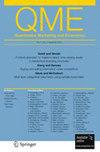Distilling network effects from Steam
IF 1.1
4区 管理学
Q3 BUSINESS
引用次数: 0
Abstract
This paper develops a method to estimate the demand for network goods, using minimal network data, but leveraging within-consumer variation. I estimate demand for video games as a function of individuals’ social networks, prices, and qualities, using data from Steam, the largest video game digital distributor in the world. I separately identify price elasticities on individuals with and without friends with the same game, conditional on individual fixed effects and games’ characteristics. I then use the discrepancies between estimated price elasticities to identify the impact of social networks. I compare my method to “traditional-IV” strategies in the literature, which require detailed network data, and find similar results. A 1% increase in friends’ demands, increases demand by .13%. In counterfactual simulations, I find demand increases by about 5% from a promotional giveaway to “influencers,” those users in the top 1% of popularity in the network.从Steam中提炼网络效应
本文开发了一种估算网络商品需求的方法,使用最小的网络数据,但利用消费者内部的变化。我使用来自Steam(世界上最大的电子游戏数字分销商)的数据,将电子游戏的需求作为个人社交网络、价格和质量的函数进行估算。根据个人固定效应和游戏特性,我分别确定了有朋友和没有朋友玩同一款游戏的个人的价格弹性。然后,我使用估计价格弹性之间的差异来确定社会网络的影响。我将我的方法与文献中需要详细网络数据的“传统iv”策略进行了比较,并发现了类似的结果。朋友的需求每增加1%,需求就会增加0.13%。在反事实的模拟中,我发现,向“影响者”(网络中人气最高的1%的用户)提供促销赠品,需求增加了约5%。
本文章由计算机程序翻译,如有差异,请以英文原文为准。
求助全文
约1分钟内获得全文
求助全文
来源期刊

Qme-Quantitative Marketing and Economics
Multiple-
CiteScore
2.30
自引率
10.50%
发文量
13
期刊介绍:
Quantitative Marketing and Economics (QME) publishes research in the intersection of Marketing, Economics and Statistics. Our focus is on important applied problems of relevance to marketing using a quantitative approach. We define marketing broadly as the study of the interface between firms, competitors and consumers. This includes but is not limited to consumer preferences, consumer demand and decision-making, strategic interaction of firms, pricing, promotion, targeting, product design/positioning, and channel issues. We embrace a wide variety of research methods including applied economic theory, econometrics and statistical methods. Empirical research using primary, secondary or experimental data is also encouraged. Officially cited as: Quant Mark Econ
 求助内容:
求助内容: 应助结果提醒方式:
应助结果提醒方式:


